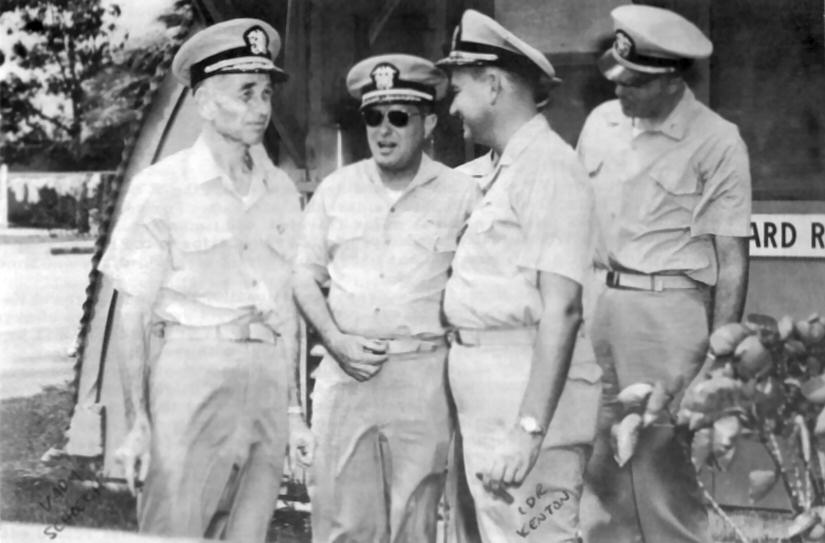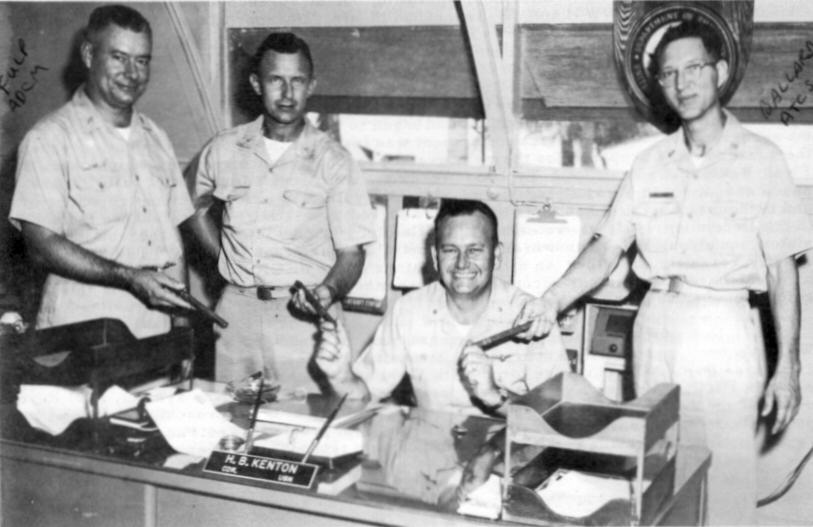FLEET GUARDIAN: AEWRON ONE
"Eternal Vigilance is the Price of Liberty" said John P. Curran, an Irish statesman in 1808. The suicidal attacks on Okinawa in WWII caused the U.S. Navy grave concern for improving its vigilance. The low flying Japanese planes were able to come close to the fleet before the shipboard radar units could detect them and alert the Combat Information Centers. These centers then tried to communicate with their own fighters in an attempt to vector them in to destroy the enemy planes. Since radar works on a line-of-sight principle, the logical method of raising the antenna to increase detection range for fleet coverage was accomplished by placing radar in an aircraft. This airborne radar platform could could then patrol the skies far out from the fleet. With experienced radar operators aboard, approaching aircraft could be quickly evaluated. In addition to radioing this early warning to the ships, the radar operators could further communicate with our protecting fighter planes and steer them to an air-to-air intercept. In short, to solve the problem of high speed warfare the Navy hoped to extend its defensive perimeter through the use of an airborne CIC crew, which would provide Airborne Early Warning.
The problems confronting these early workers were staggering. However, they fortunately received strong encouragement from the "top brass", who recognized the potentialities of AEW. Consequently, the original project Cadillac II, which was initiated towrd the war's end, was kept alive in late 1945 and 1946. Among the problems to be solved was developing a radar compact enough to be placed in an aircraft and sturdy enough to withstand the vibration received in rough air and on landings. This radar had to be complex enough to furnish the vital information concerning speeds, heights, and distances to the Combat Information Center; which needed excellent radio and telephone equipment for communication, both inside the aircraft and to other ships and aircraft.
The aircraft, in turn had to be large enough to house the radar, the multiple radar scopes, and the CIC team. Furthermore, it had to be capable of patrolling for many hours, the longer the better! Cadillac II workers turned to the old reliable B-17 bomber for these requirements. The Navy dubbed them PB-1W's. The first squadron to experiment with AEW was Experimental Squadron Four (VX-4) operating out of Norfolk.
VX-4 participated in two "first" in 1946. It flew the first Navy radar weather reconnaissance flight on a hurricane in the Atlantic. It also participated in the first operational AEW mission, Admiral Marc Mitsher had zig-zagged his fleet from the Caribean to New Youk, where he was handed a complete and accurate track of his voyage, courtesy VX-4's airborne radar coverage.
The first AEW type squadron was VPW-1 which operated on the East coast, AEWRON ONE evolved from a VC-11 (now VAW-11) detachment, which was a West Coast outgrowth of VPW-1. This unit was commissioned Airborne Early Warning Squadron ONE (VW-1) on 18 June 1952 at NAS Barber's Point, Hawaii, making it the firs landbased AEW squadron in the Pacific. The squadron had only a few of the old PB-1W's, adaptations of the AirForce B-17.
The PB-1W's crossed the Pacific in February of 1953 when VW-1 deployed to Korea for a brief taste of combat patroling. In October 1954, the squadron received its first WV-2 Warning Star, the Navy's radar configurated version of Lockeed's Super Constellation air liners with the famed triple-tail trademark of Lockheed. Easily distiguishable is the "fin" atop the fuselage which houses the height-finding radar gear, and the large"bubble" underneath which contains the distance-measuring radar. This bubble has led some people to dub the aircraft "careless Connie". VW-1 has its own club, "The Order of the Pregnant Geese", which accepts crew members who have accumulated 200 flight hours in our beloved "pregnant goose".
Regardless of her name, VW-1 has had astounding success with the WV-2, logging over 70,000 accident-free flying hours with this remarkable aircraft. For you statisticians, that's the equivalent of 11 million nautical miles traveled, 440 times around the earth at the equator, or for yo astronautically minded people, 22 round trips to the moon. That is quite a bit of travelling for a squadron that has never had over 12 aircraft at one time.
VW-1 and its WV-2's were an immediate success operationally. Fleet units around Hawaii were pleased with the performance of our radar which could sweep an area of over 100,000 square miles six times a minute in its search for enemies or weather. VW-1 was called upon to provide a permanent detachment for exercises with the 7th Fleet in WestPac. This detachment operated out of Sangley Pt., Cubi Pt., Naha and Atsugi. Our aircraft participated in the Tachan evacuation in 1955 and Taiwan Straits patrol through 1957. At the same time the highly important barrier line stretching across the northern Pacific from Hawaii to Midway to Alaska was started. VW-1 initially trained these crews. VW-1's new sister squadrons were called upon to provide 24 hour coverage for this segment of the far flung DEW (Distant Early Warning) which stretches entirely around the USA and Canada from the Pacific through the Arctic to the north Atlantic. In 1957, VW-1 was ordered to NAS Agana, Guam to provide closer support for the powerful 7th Fleet. The Commanding Officer of VW-1 has traditionally been Commander Fleet Air Detachment (CFAD) Guam and designated Commander Task Group 70.3. Administrative control has rested with Commander Fleet air Southwest Pacific (ComFairSowestPac). From 1957 to 1960 NAS Agana was a beehive of activity with squadrons VW-1 and VW-3 fully manned and frequently deploying on AEW missions, operating out of advance air bases in the Philippines, Okinawa, and Japan. VW-1 and VW-3 each had 12 aircraft, approximately 120 officers and 600 enlisted men. On 1 July 1960 VW-3 was deactivated. Its planes were sent to Arizona for mothballing; and most of the personnel rotated to other assignments; quite a few officers and men were absorbed into VW-1. VW-1 was told to begin training for the additional mission of weather reconnaissance. On 1 July 1961 the primary mission of the squadron became weather reconnaissance, though we retained much of our AEW commitments to the 7th Fleet. By this time the squadron had received and begun to train 6 flight aerologists and 18 enlisted aerographers.
Meteorological equipment was installed in all the the aircraft. Consequently the squadron was prepared for the many weather reconnaissance requests which came from Fleet Weather Central/Joint Typhoon Warning Center located on Nimitz Hill. Its first typhoon season found VW-1 flying 114 missions including 85 critical fixes on tropical storms and typhoons. A total of 854 flight hours were logged on weather reconnaissance from 1 July to 31 December 1961, as we earned the title of "Typhoon Trackers", thereby joining our sister squadron, VW-4, known as the Atlantic's "Hurricane Hunters". The WV-2 proved equally versatile as either and airborne weather office or CIC platform. Guam also proved an ideal base for weather reconnaissance as most of the storms originated in this region before moving west and/or north-westward.
VW-1 looks forward to its 10th anniversary on 18 June 1962 with increased confidence. We have been reduced to 6 operational aircraft, 61 officers and 395 enlisted men, but our dual mission of AEW coverage for the 7th Fleet and weather reconnaissance for the entire western Pacific gives us a very strong operational base. Our squadron symbol, Paul Revere mounted on the white horse, Pegasus, riding to warn of the approaching enemy will undoubtedly remain both familiar and appropriate to the people in WestPac for years to come as we continue to provide early warning of possible typhoons and enemy aircraft.
 Howard B. Kenton, VW-1 CO 3rd from left with the Admiral (COMNAVMAR) and other officers in
front of the VW-1 Ward Room.
Howard B. Kenton, VW-1 CO 3rd from left with the Admiral (COMNAVMAR) and other officers in
front of the VW-1 Ward Room.
 Howard B. Kenton, VW-1 CO is presented with cigars from a few of the VW-1 chiefs at the
VW-1 10th anniversary.
Howard B. Kenton, VW-1 CO is presented with cigars from a few of the VW-1 chiefs at the
VW-1 10th anniversary.
